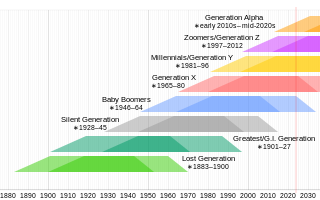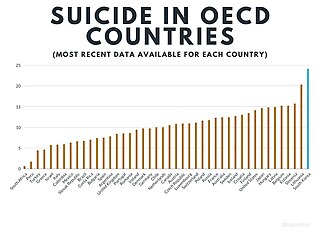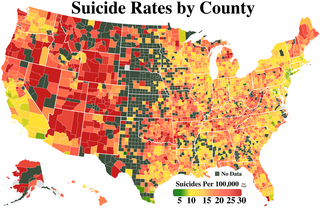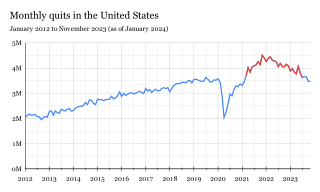Related Research Articles

Generation X is the demographic cohort following the Baby Boomers and preceding Millennials. Researchers and popular media often use the mid-1960s as its starting birth years and the late 1970s as its ending birth years, with the generation being generally defined as people born from 1965 to 1980. By this definition and U.S. Census data, there are 65.2 million Gen Xers in the United States as of 2019. Most of Generation X are the children of the Silent Generation and early Baby Boomers; Xers are also often the parents of Millennials and Generation Z.

Millennials, also known as Generation Y or Gen Y, are the demographic cohort following Generation X and preceding Generation Z. Researchers and popular media use the early 1980s as starting birth years and the mid-1990s to early 2000s as ending birth years, with the generation typically being defined as people born from 1981 to 1996. Most Millennials are the children of Baby Boomers and older Generation X. In turn Millennials are often the parents of Generation Alpha.
The Wall Street Journal (WSJ), also referred to simply as theJournal, is an American newspaper based in New York City, with a focus on business and finance. It operates on a subscription model, requiring readers to pay for access to its articles and content. The Journal is published six days a week by Dow Jones & Company, a division of News Corp. The first issue was published on July 8, 1889.
Voluntary childlessness or childfreeness describes the active choice not to have children. Use of the word "childfree" was first recorded in 1901 and entered common usage among feminists during the 1970s. The suffix -free refers to the freedom and personal choice of those to pick this lifestyle. The meaning of the term childfree extends to encompass the children of others, and this distinguishes it further from the more usual term childless, which is traditionally used to express the idea of having no children, whether by choice or by circumstance. In the research literature, the term child-free or childfree has also been used to refer to parents currently not living with their children, for example because they have already grown up and moved out. In common usage, childfree might be used in the context of venues or activities wherein (young) children are excluded even if the people involved may be parents, such as a childfree flight or a childfree restaurant.

Mental health encompasses emotional, psychological, and social well-being, influencing cognition, perception, and behavior. According to World Health Organization (WHO), it is a "state of well-being in which the individual realizes his or her abilities, can cope with the normal stresses of life, can work productively and fruitfully, and can contribute to his or her community". It likewise determines how an individual handles stress, interpersonal relationships, and decision-making. Mental health includes subjective well-being, perceived self-efficacy, autonomy, competence, intergenerational dependence, and self-actualization of one's intellectual and emotional potential, among others. From the perspectives of positive psychology or holism, mental health may include an individual's ability to enjoy life and to create a balance between life activities and efforts to achieve psychological resilience. Cultural differences, personal philosophy, subjective assessments, and competing professional theories all affect how one defines "mental health". Some early signs related to mental health difficulties are sleep irritation, lack of energy, lack of appetite, thinking of harming oneself or others, self-isolating, and frequently zoning out.

The neurodiversity paradigm is a framework for understanding human brain function that recognizes the diversity within sensory processing, motor abilities, social comfort, cognition, and focus as neurobiological differences. The neurodiversity paradigm argues that diversity in human cognition is normal and that some conditions generally classified as disorders, such as autism, are differences and disabilities that are not necessarily pathological.
Self-deprecation is the act of reprimanding oneself by belittling, undervaluing, disparaging oneself, or being excessively modest. It can be used as a way to make complaints, express modesty, invoke optimal reactions or add humour. It may also be used as a way for individuals to appear more likable and agreeable.

Generation Z, also known as Zoomers, is the demographic cohort succeeding Millennials and preceding Generation Alpha. Researchers and popular media use the mid-to-late 1990s as starting birth years and the early 2010s as ending birth years, with the generation most frequently being defined as people born from 1997 to 2012. Most members of Generation Z are the children of younger Baby Boomers or Generation X.

Social media are interactive technologies that facilitate the creation, sharing and aggregation of content amongst virtual communities and networks. Common features include:

Telepsychiatry or telemental health refers to the use of telecommunications technology to deliver psychiatric care remotely for people with mental health conditions. It is a branch of telemedicine.

South Korea records the world's fourth highest suicide rate, and the highest suicide rate in the OECD. The elderly are at the highest risk of suicide, but teen suicide deaths have been rising since 2010: Suicide caused more than half of all deaths among South Koreans in their 20s in 2022, and it is the leading cause of death among those in their teens, 20s, and 30s.

Suicide is a major national public health issue in the United States. The country has one of the highest suicide rates among wealthy nations. In 2020, there were 45,799 recorded suicides, up from 42,773 in 2014, according to the CDC's National Center for Health Statistics (NCHS). On average, adjusted for age, the annual U.S. suicide rate increased 30% between 2000 and 2020, from 10.4 to 13.5 suicides per 100,000 people. In 2018, 14.2 people per 100,000 died by suicide, the highest rate recorded in more than 30 years. Due to the stigma surrounding suicide, it is suspected that suicide is generally underreported. In April 2016, the CDC released data showing that the suicide rate in the United States had hit a 30-year high, and later in June 2018, released further data showing that the rate has continued to increase and has increased in every U.S. state except Nevada since 1999. From 2000 to 2020, more than 800,000 people died by suicide in the United States, with males representing 78.7% of all suicides that happened between 2000 and 2020. In 2022, a record high 49,500 people died by suicide, while the suicide rate in 2022 reached its highest level since 1941 at 14.3 per 100,000 persons. However, this rate was surpassed in 2023, when it further increased to over 14.7 per 100,000 persons. Surging death rates from suicide, drug overdoses and alcoholism, what researchers refer to as "deaths of despair," are largely responsible for a consecutive three year decline of life expectancy in the U.S. This constitutes the first three-year drop in life expectancy in the U.S. since the years 1915–1918.

TikTok, whose mainland Chinese counterpart is Douyin, is a short-form video hosting service owned by Chinese internet company ByteDance. It hosts user-submitted videos, which can range in duration from three seconds to 60 minutes. It can be accessed with a smart phone app.

Generation Z, colloquially known as Zoomers, is the demographic cohort succeeding Millennials and preceding Generation Alpha.
The relationships between digital media use and mental health have been investigated by various researchers—predominantly psychologists, sociologists, anthropologists, and medical experts—especially since the mid-1990s, after the growth of the World Wide Web and rise of text messaging. A significant body of research has explored "overuse" phenomena, commonly known as "digital addictions", or "digital dependencies". These phenomena manifest differently in many societies and cultures. Some experts have investigated the benefits of moderate digital media use in various domains, including in mental health, and the treatment of mental health problems with novel technological solutions.
Suicide in Ireland has the 17th highest rate in Europe and the 4th highest for the males aged 15–25 years old which was a main contributing factor to the improvement of suicides in Ireland.

The COVID-19 pandemic has impacted the mental health of people across the globe. The pandemic has caused widespread anxiety, depression, and post-traumatic stress disorder symptoms. According to the UN health agency WHO, in the first year of the COVID-19 pandemic, prevalence of common mental health conditions, such as depression and anxiety, went up by more than 25 percent. The pandemic has damaged social relationships, trust in institutions and in other people, has caused changes in work and income, and has imposed a substantial burden of anxiety and worry on the population. Women and young people face the greatest risk of depression and anxiety. According to The Centers for Disease Control and Prevention study of Mental Health, Substance Use, and Suicidal Ideation During the COVID-19 Pandemic, "63 percent of young people reported experiencing substantial symptoms of anxiety and depression".

The COVID-19 pandemic has had many impacts on global health beyond those caused by the COVID-19 disease itself. It has led to a reduction in hospital visits for other reasons. There have been 38 per cent fewer hospital visits for heart attack symptoms in the United States and 40 per cent fewer in Spain. The head of cardiology at the University of Arizona said, "My worry is some of these people are dying at home because they're too scared to go to the hospital." There is also concern that people with strokes and appendicitis are not seeking timely treatment. Shortages of medical supplies have impacted people with various conditions.

Doomscrolling or doomsurfing is the act of spending an excessive amount of time reading large quantities of news, particularly negative news, on the web and social media. Doomscrolling can also be defined as the excessive consumption of short-form videos or social media content for an excessive period of time without stopping. The concept was coined around 2020, particularly in the context of the COVID-19 pandemic.

The Great Resignation, also known as the Big Quit and the Great Reshuffle, was a mainly American economic trend in which employees voluntarily resigned from their jobs en masse, beginning in early 2021 during the COVID-19 pandemic. Among the most cited reasons for resigning included wage stagnation amid rising cost of living, limited opportunities for career advancement, hostile work environments, lack of benefits, inflexible remote-work policies, and long-lasting job dissatisfaction. Most likely to quit were workers in hospitality, healthcare, and education. In addition, many of the resigning workers were retiring Baby Boomers, who are one of the largest demographic cohorts in the United States.
References
- ↑ Alavanza, Mary (10 October 2023). "Funemployment: Young Singaporeans say unemployment can be fun - Singapore News". The Independent Singapore News. Retrieved 23 June 2024.
- ↑ Bruner, Raisa (29 October 2021). "Young People Are Leaving Their Jobs in Record Numbers—And Not Going Back". TIME. Retrieved 23 June 2024.
- ↑ "What Americans think of Gen Z's 'funemployment' attitude | CNN Business". 20 May 2023. Retrieved 23 June 2024.
- ↑ Jones, Owen (15 May 2011). "It's time to clamp down on 'funemployment'". The Guardian. Retrieved 23 June 2024.
- ↑ "Would Gen Z Rather Be 'Funemployed'?: There is nothing fun about seeing friends move on with their lives while you, standing still, are left behind". Wall Street Journal. May 22, 2023. Retrieved 23 June 2024.
- ↑ Tait, Amelia (August 4, 2021). "Why the young and jobless are rebranding as funemployed". The Face. Retrieved 23 June 2024.
- ↑ "Not So 'Funemployed': How Unemployment Can Take A Toll On Your Mental Health". Medical Daily. 22 September 2015. Retrieved 23 June 2024.
- ↑ Welch, Suzy (May 17, 2023). "For Gen Z, Unemployment Can Be a Blast". Wall Street Journal. Retrieved 23 June 2024.
- ↑ Yoshino, Kimi (4 June 2009). "For the 'funemployed,' unemployment is welcome". Los Angeles Times. Retrieved 23 June 2024.